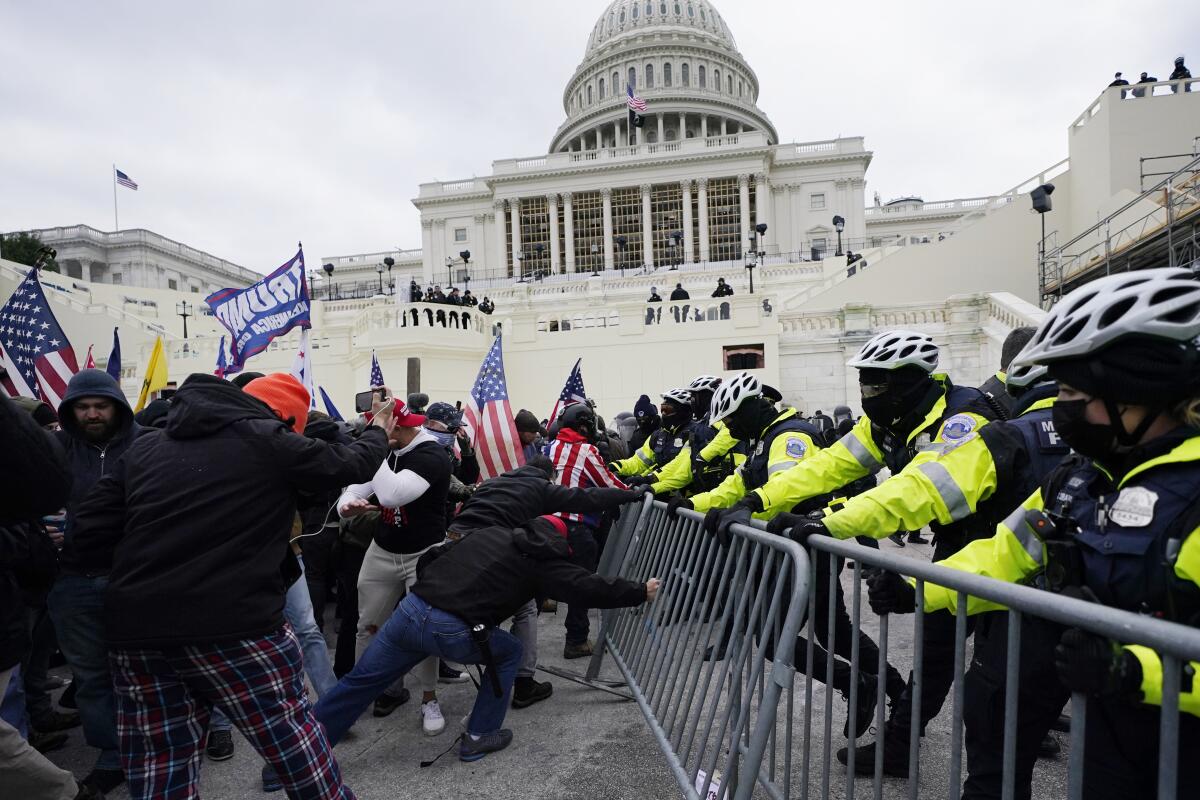FBI, Homeland Security ignored huge amount of intelligence before Jan. 6 riot, Senate report says

- Share via
WASHINGTON — The FBI and the Department of Homeland Security downplayed or ignored “a massive amount of intelligence information” ahead of the Jan. 6 attack on the U.S Capitol, according to the chairman of a Senate panel that is releasing a new report Tuesday on the intelligence failures ahead of the insurrection.
The report details how the agencies failed to recognize and warn of the potential for violence as some of then-President Trump’s supporters openly planned the siege in messages and forums online.
Among the multitude of overlooked intelligence was a December 2020 tip to the FBI that members of the far-right group Proud Boys planned to be in Washington for the certification of President Biden’s victory and that their “plan is to literally kill people,” the report said. The Senate Homeland Security and Governmental Affairs Committee said the agencies were also aware of many social media posts that foreshadowed violence, some calling on Trump’s supporters to “come armed” and storm the Capitol, kill lawmakers or “burn the place to the ground.”
Sen. Gary Peters (D-Mich.), the chairman of the Homeland panel, said the breakdown was “largely a failure of imagination to see threats that the Capitol could be breached as credible,” echoing the findings of the Sept. 11 commission about intelligence failures ahead of the 2001 terrorist attacks on New York and Washington, D.C.
The report by the panel’s majority staff says the intelligence community has not entirely recalibrated to focus on the threats of domestic, rather than international, terrorism. And government intelligence leaders failed to sound the alarm “in part because they could not conceive that the U.S. Capitol Building would be overrun by rioters.”
Still, Peters said, the reasons for dismissing what he called a “massive” amount of intelligence “defies an easy explanation.”
Two Florida men who stormed the U.S. Capitol were sentenced to three years in prison for seditious conspiracy and other crimes.
While several other reports have examined the intelligence failures around Jan. 6 — including a bipartisan 2021 Senate report, the House Jan. 6 committee last year and several separate internal assessments by the Capitol Police and other government agencies — the latest investigation is the first congressional report to focus solely on the actions of the FBI and the Department of Homeland Security’s Office of Intelligence and Analysis.
In the wake of the attack, Peters said the committee interviewed officials at both agencies and found what was “pretty constant finger-pointing” at each other.
“Everybody should be accountable because everybody failed,” Peters said.
Using emails and interviews collected by the Senate committee and others, including from the House Jan. 6 panel, the report lays out in detail the intelligence the agencies received in the weeks ahead of the attack.
There was not a failure to obtain evidence, the report says, but the agencies “failed to fully and accurately assess the severity of the threat identified by that intelligence, and formally disseminate guidance to their law enforcement partners.”
As Trump falsely claimed to have won the 2020 election and tried to overturn his defeat, telling his supporters to “ fight like hell” in a speech in front of the White House that day, thousands of them marched to the Capitol. More than 2,000 rioters overran law enforcement, assaulted police officers and caused more than $2.7 billion in damage to the Capitol, according to a U.S. Government Accountability Office report this year.
Breaking through windows and doors, the rioters sent lawmakers running for their lives and temporarily interrupted the certification of Biden’s election victory.
Even as the attack was happening, the new report found, the FBI and Homeland Security downplayed the threat. As the Capitol Police struggled to clear the building, Homeland Security “was still struggling to assess the credibility of threats against the Capitol and to report out its intelligence.”
Trump White House officials said the president called Vice President Mike Pence a ‘wimp’ and ‘the P-word.’
And at a 10 a.m. briefing that morning, even as protesters at Trump’s speech and near the Capitol were “wearing ballistic helmets, body armor, carrying radio equipment and military grade backpacks,” the FBI briefed that there were “no credible threats at this time.”
The lack of sufficient warnings meant that law enforcement was not adequately prepared and there was not a hardened perimeter established around the Capitol, as there is during events like the State of the Union address.
The report contains dozens of tips about violence on Jan. 6 that the agencies received and dismissed either because of lack of coordination, bureaucratic delays or trepidation on the part of those collecting the information. The FBI, for example, was unexpectedly hindered in its attempt to find social media posts planning for Jan. 6 protests when the contract for its third-party social media monitoring tool expired. At Homeland Security, analysts were hesitant to report open-source intelligence after criticism in 2020 for collecting intelligence on U.S. citizens during racial justice demonstrations.
One tip received by the FBI ahead of the Jan. 6 attack was from a former Justice Department official who sent screenshots of online posts from members of the Oath Keepers extremist group: “There is only one way in. It is not signs. It’s not rallies. It’s f— bullets!”
Oath Keepers founder Stewart Rhodes is sentenced after a landmark verdict convicting him of sedition in leading a plot to keep former President Trump in power.
The social media company Parler, a favored platform for Trump’s supporters, directly sent the FBI several posts it found alarming, adding that there was “more where this came from” and that it was concerned about what would happen Jan. 6.
”[T]his is not a rally and it’s no longer a protest,” read one of the Parler posts sent to the FBI, according to the report. “This is a final stand where we are drawing the red line at Capitol Hill. ... don’t be surprised if we take the #capital [sic] building.”
But even as it received the warnings, the Senate panel found, the agency said over and over again that there were no credible threats.
“Our nation is still reckoning with the fallout from January 6th, but what is clear is the need for a reevaluation of the federal government’s domestic intelligence collection, analysis, and dissemination processes,” the new report says.
News Alerts
Get breaking news, investigations, analysis and more signature journalism from the Los Angeles Times in your inbox.
You may occasionally receive promotional content from the Los Angeles Times.
In a statement, Homeland Security spokesperson Angelo Fernandez said that the department has made many of those changes 2½ years later. The department “has strengthened intelligence analysis, information sharing, and operational preparedness to help prevent acts of violence and keep our communities safe.”
The FBI said in a separate response that, since the attack, it has increased focus on “swift information sharing” and centralized the flow of information to ensure more timely notification to other entities. “The FBI is determined to aggressively fight the danger posed by all domestic violent extremists, regardless of their motivations,” the statement said.
FBI Director Christopher A. Wray has defended the FBI’s handling of intelligence in the run-up to Jan. 6, including a report from its Norfolk, Va., field office Jan. 5 that cited online posts foreshadowing the possibility of a “war” in Washington the following day. The Senate report noted that the memo “did not note the multitude of other warnings” the agency had received.
The fault-finding with the FBI and Homeland Security Department echoes the blistering criticism directed at U.S. Capitol Police in a bipartisan report issued by the Senate Homeland and Rules committees two years ago. That report found that the police intelligence unit knew about social media posts calling for violence as well but did not inform top leadership of what they had found.
Peters says he asked for the probe of the intelligence agencies after other reports, such as the House panel’s investigation last year, focused on other aspects of the attack. The Jan. 6 panel was more focused on Trump’s actions and concluded in its report that the former president criminally engaged in a “multi-part conspiracy” to overturn the lawful results of the 2020 presidential election and failed to act to stop his supporters from attacking the Capitol.
“It’s important for us to realize these failures to make sure it doesn’t happen again,” Peters said.
More to Read
Sign up for Essential California
The most important California stories and recommendations in your inbox every morning.
You may occasionally receive promotional content from the Los Angeles Times.
















